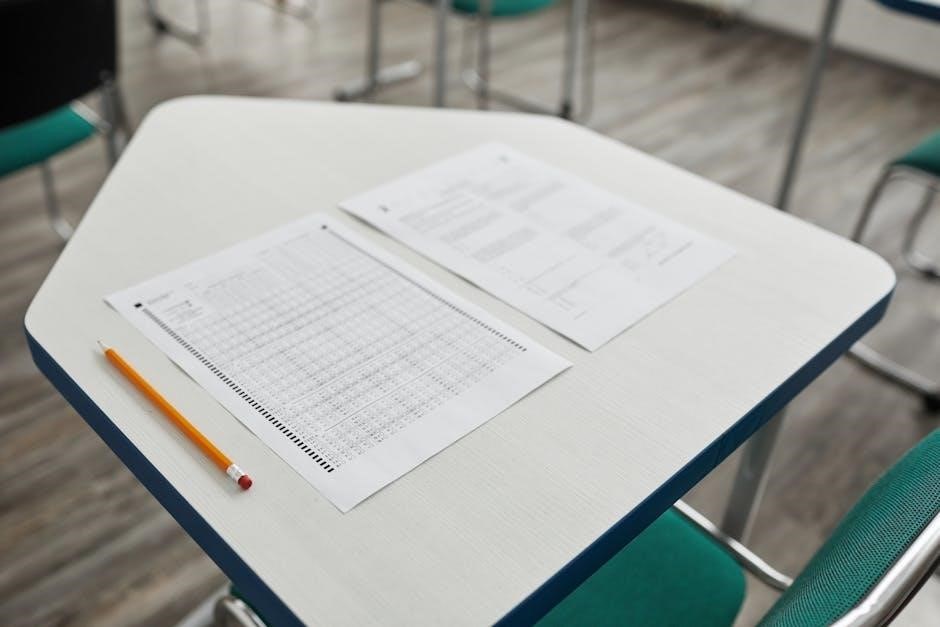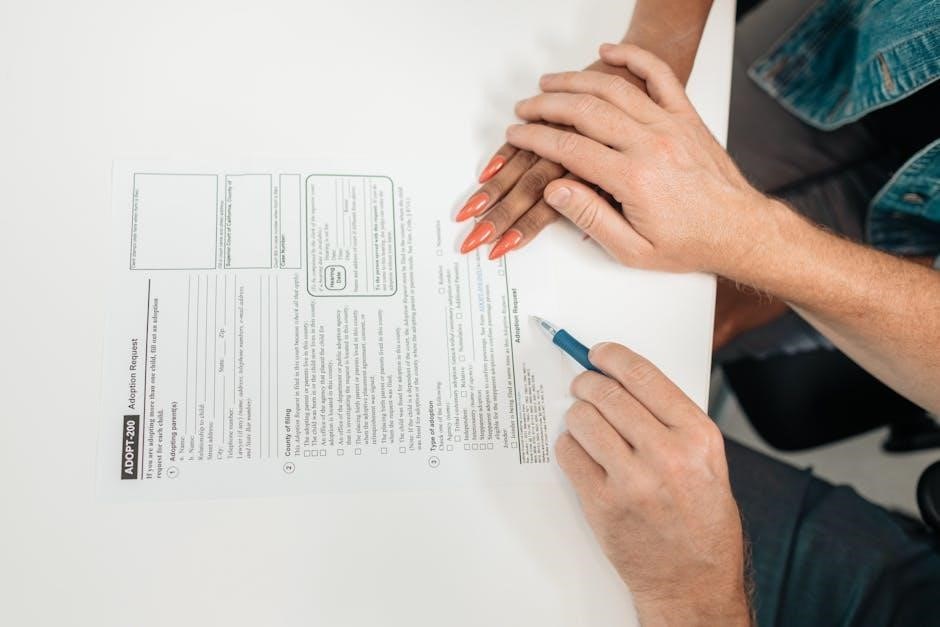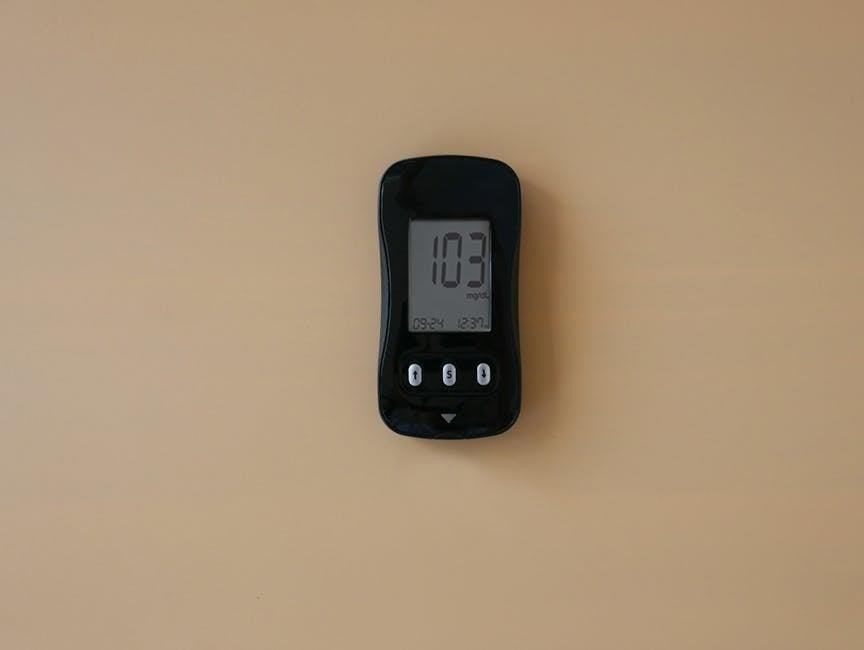Year 3 maths worksheets with answers PDF provide structured practice, enhancing understanding of core concepts․ They align with curriculum standards, offering immediate feedback and fostering confidence in young learners․
1․1 Importance of Practice in Maths Education
Regular practice is essential for building a strong foundation in mathematics․ It helps students develop problem-solving skills, understand core concepts, and retain information effectively․ Through consistent practice, learners gain confidence in their abilities and improve their speed and accuracy․ Worksheets with answers provide immediate feedback, allowing students to identify and correct mistakes․ This iterative process fosters a deeper understanding and a growth mindset, crucial for long-term success in maths․ Practice also enhances logical reasoning and critical thinking, which are vital for academic and real-world applications․
1․2 Benefits of Using Worksheets with Answers
Worksheets with answers offer numerous benefits for effective learning․ They provide immediate feedback, allowing students to verify their work and understand mistakes․ This self-correction process enhances understanding and retention of concepts․ Answers also serve as a guide for parents and teachers, enabling them to track progress and identify areas needing improvement․ Additionally, having solutions readily available saves time and ensures accuracy․ Worksheets with answers foster independent learning, build confidence, and align with curriculum standards, making them a valuable resource for maths education․
1․3 Overview of Year 3 Maths Curriculum
The Year 3 maths curriculum focuses on building foundational skills in number, shape, and measurement․ It introduces concepts like place value, addition, subtraction, multiplication, and division, while exploring geometry, time, and data handling․ The curriculum emphasizes logical reasoning and problem-solving, preparing students for more complex maths in later years․ Worksheets align with these goals, offering structured practice to reinforce learning and ensure a solid understanding of key mathematical principles․

Key Topics Covered in Year 3 Maths Worksheets
Year 3 maths worksheets cover essential topics such as number operations, geometry, measurement, and data handling, providing a comprehensive foundation for young learners’ mathematical development and problem-solving skills․
2․1 Number and Place Value
Number and place value form the backbone of Year 3 maths, focusing on understanding the value of digits within numbers․ Worksheets help students master reading and writing three-digit numbers, identifying hundreds, tens, and units, and applying place value to solve arithmetic problems․ These skills are essential for building a strong mathematical foundation, enabling students to tackle more complex operations with confidence․ Practical exercises and real-life examples enhance comprehension, while answers provide immediate feedback to reinforce learning and accuracy․
2․2 Addition and Subtraction
Addition and subtraction are foundational skills in Year 3 maths, with worksheets focusing on mental maths strategies, column methods, and word problems․ These exercises help students develop accuracy and fluency in calculations, while applying place value understanding to solve problems confidently․ Worksheets with answers provide immediate feedback, reinforcing learning and ensuring students grasp these essential arithmetic operations․ Regular practice through structured activities builds a strong base for more complex maths concepts in later years․
2․3 Multiplication and Division

Year 3 maths worksheets focus on building proficiency in multiplication and division, introducing times tables and basic division concepts․ Worksheets include exercises on multiplying and dividing by single and double-digit numbers, with word problems to apply these skills in real-life scenarios․ Answers provided allow students to check their work, fostering accuracy and confidence․ Regular practice helps students master these operations, forming a solid foundation for more advanced maths in future years․
2․4 Shapes and Geometry
Year 3 maths worksheets cover essential shape and geometry skills, helping students identify and name basic 2D and 3D shapes․ Activities include sorting shapes by properties, understanding symmetry, and exploring patterns․ Worksheets also introduce basic geometry tools like rulers and compasses․ Answer keys provide immediate feedback, ensuring students grasp concepts like angles, lines, and shape transformations․ These exercises build spatial awareness and problem-solving skills, preparing students for more complex geometry in later years․
2․5 Measurement and Time
Year 3 maths worksheets focus on measurement and time, helping students grasp concepts like length, weight, and capacity․ Activities include reading analog clocks, calculating durations, and converting units․ Worksheets also cover comparing times and solving word problems involving measurement․ Answer keys provide clear solutions, reinforcing accuracy and understanding․ These exercises build foundational skills for real-world applications, ensuring students can confidently measure objects and tell time accurately, which are essential for everyday life and further maths studies․
2․6 Data Handling
Data handling worksheets for Year 3 focus on collecting, organizing, and interpreting information․ Students learn to create simple charts, graphs, and tables to represent data․ Activities include categorizing objects, creating pictograms, and solving problems using data․ Answer keys provide correct interpretations, helping students understand how to analyze and draw conclusions from information․ These exercises develop critical thinking and problem-solving skills, preparing students to work confidently with data in real-world scenarios and future academic challenges․

How to Use Year 3 Maths Worksheets Effectively
Set up a consistent study routine, encouraging self-correction and interactive learning․ Use worksheets to reinforce concepts, track progress, and build confidence in problem-solving skills for young learners․
3․1 Setting Up a Study Routine
Establishing a consistent study routine is crucial for effective maths practice․ Dedicate specific times daily for worksheet exercises, ensuring a quiet, distraction-free environment․ Start with familiar topics to build confidence, then gradually introduce more challenging problems․ Use the provided answers to check progress and understanding․ Incorporate short breaks to maintain focus and engagement․ Consistency helps reinforce maths concepts and develops a strong foundation for future learning․ Regular practice fosters discipline and improves problem-solving skills in young students․
3․2 Encouraging Self-Correction
Encouraging self-correction helps students take ownership of their learning․ After completing worksheets, they can compare their answers with the provided solutions to identify errors․ This process fosters a deeper understanding of concepts and reduces reliance on others for corrections․ Teach them to review mistakes carefully, ensuring they grasp where they went wrong․ Over time, this practice builds confidence and improves accuracy, as students learn to approach problems with a more critical and independent mindset․
3․3 Making Learning Interactive
Making learning interactive enhances engagement and understanding․ Incorporate games, puzzles, and real-world applications alongside worksheets to make maths fun․ Use visual aids like graphs or manipulatives to simplify complex concepts․ Encourage group activities where students solve problems together, fostering teamwork and communication․ Interactive tools, such as maths apps or online quizzes, can also make practice dynamic and enjoyable, helping Year 3 students stay motivated and develop a positive attitude toward maths․

Finding Reliable Year 3 Maths Worksheets with Answers
Reliable Year 3 maths worksheets with answers are available online, offering free and paid resources․ Ensure they align with curriculum standards for effective learning and progression․
4․1 Free Resources Available Online
Free Year 3 maths worksheets with answers are widely available online, offering convenient access to high-quality materials․ Many websites provide downloadable PDFs, created by teachers, covering topics like number operations, geometry, and measurement․ These resources are designed to align with curriculum standards, ensuring relevance and effectiveness․ They often include interactive elements, such as puzzles and colouring activities, to engage young learners․ Parents and educators can easily print these worksheets for offline use, making them a practical tool for supplementary learning․ The inclusion of answers supports self-correction, fostering independent learning and confidence in maths skills․
4․2 Paid Resources and Their Advantages
Paid Year 3 maths resources often provide comprehensive, well-structured content with detailed answer keys, ensuring accuracy and ease of use․ Many include interactive elements like videos or multimedia to engage learners․ These resources are typically created by professionals, guaranteeing alignment with curriculum standards․ They cover a wide range of topics, such as number operations, geometry, and measurement․ Additionally, paid materials frequently offer regular updates, ensuring fresh and relevant content for continuous learning․ This makes them a valuable investment for effective maths education․
4․3 How to Choose the Right Worksheets
When selecting Year 3 maths worksheets with answers, ensure they align with the curriculum and cater to your child’s learning needs․ Opt for resources with clear, legible layouts and accurate answer keys․ Consider interactive elements like videos or multimedia for engagement․ Check for reviews or recommendations to ensure reliability․ Choose worksheets that offer a variety of difficulty levels or adaptable content․ Ensure they are easy to download and print, and look for resources that are regularly updated for fresh content․

Common Challenges in Year 3 Maths
Students often struggle with understanding place value, mastering basic arithmetic, and solving word problems․ These challenges can hinder confidence, making structured practice essential for improvement․
5․1 Understanding Place Value
Understanding place value is a fundamental challenge for many Year 3 students․ It involves grasping concepts like hundreds, tens, and units, which are essential for basic arithmetic․ Worksheets with answers provide structured exercises to help students recognize and manipulate numbers․ Visual aids, such as place value charts, can make abstract ideas clearer; Regular practice with immediate feedback helps build confidence and fluency in this critical area of maths․
5․2 Mastering Basic Arithmetic Operations
Mastering basic arithmetic operations like addition, subtraction, multiplication, and division is a common challenge for Year 3 students․ Worksheets with answers provide targeted practice, helping students build fluency and accuracy․ Repeated exposure to problems enhances understanding and reduces errors․ Immediate feedback from answers allows students to identify mistakes and improve․ Visual aids and step-by-step solutions also support learning, making complex operations more manageable and fostering a strong foundation for future maths skills․
5․3 Solving Word Problems
Solving word problems is a significant challenge for Year 3 students, as it requires both reading comprehension and mathematical skills․ Worksheets with answers provide structured examples, helping students break down problems into manageable steps․ Visual aids and real-world contexts make abstract concepts clearer․ Immediate feedback from answers enables students to identify errors and improve their approach․ Regular practice builds confidence and enhances problem-solving strategies, preparing students for more complex maths challenges in higher grades․

Tips for Parents and Guardians
Encourage daily practice with worksheets, provide feedback, and communicate with teachers․ Praise efforts, make learning interactive, and stay involved to support progress․
6․1 Supporting Your Child’s Maths Learning
Parents can support their child’s maths learning by creating a positive environment․ Encourage daily practice with worksheets, praising efforts to build confidence․ Use the answers provided to review and discuss mistakes, fostering understanding․ Make learning interactive with real-life examples and fun activities․ Stay updated on their progress and communicate with teachers for additional support․ Celebrate small achievements to keep motivation high and help your child develop a strong foundation in maths․
6․2 Communicating with Teachers
Regular communication with teachers is crucial for supporting your child’s maths learning․ Schedule meetings or send emails to stay updated on their progress and understand classroom strategies․ Teachers can provide insights into your child’s strengths and challenges, helping you tailor home practice․ Discuss how worksheets with answers can reinforce classroom lessons and address specific areas where your child needs extra support․ Collaborative communication ensures a consistent learning environment and helps your child succeed․
6․3 Encouraging a Growth Mindset
Encouraging a growth mindset helps children view challenges as opportunities to learn․ Praise effort, not just results, and emphasize that mistakes are part of the learning process․ Celebrate progress, no matter how small, to build confidence․ Use maths worksheets with answers to demonstrate improvement over time․ Discuss problem-solving strategies openly, fostering resilience and a love for learning․ This approach helps children believe their abilities can grow with dedication and practice․

Best Practices for Teachers
Teachers should integrate Year 3 maths worksheets into lessons, aligning with curriculum goals․ Regular review of answers helps identify areas needing support, enabling targeted instruction․
7․1 Integrating Worksheets into Lesson Plans
Teachers can effectively integrate Year 3 maths worksheets into lesson plans by aligning them with curriculum standards․ Use worksheets to introduce new topics or reinforce concepts․ Start with guided practice, then allow independent work․ Incorporate the answers for immediate feedback, helping students track progress․ Differentiate instruction by selecting worksheets tailored to varying skill levels․ Embed interactive elements, like puzzles or real-world problems, to keep students engaged․ Rotate worksheet types to maintain interest and cover all maths areas comprehensively․
7․2 Providing Feedback
Providing feedback is essential for student growth in maths․ Use the answers in worksheets to correct misconceptions promptly․ Highlight correct answers and explain errors clearly․ Encourage students to reflect on their mistakes to deepen understanding․ Positive reinforcement for correct work motivates learners․ Regular feedback helps track progress and identifies areas needing review․ Make feedback specific, constructive, and focused on improvement․ This approach fosters a supportive learning environment and helps students build confidence in their maths skills over time․
7․3 Differentiating Instruction
Differentiating instruction ensures all students receive tailored support․ Teachers can modify year 3 maths worksheets to suit individual needs, offering challenging or simplified problems․ Incorporating visual aids and hands-on activities caters to diverse learning styles․ The answers provided in worksheets help teachers assess understanding and adjust instruction․ By varying question types and complexity, teachers can address different learning paces and abilities, ensuring every student progresses effectively in their maths journey․

The Importance of Answers in Worksheets
Answers in worksheets provide immediate feedback, helping students verify their work․ They support parents in monitoring progress and encourage independent learning, fostering confidence and self-correction skills effectively․
8․1 Immediate Feedback for Students
Immediate feedback is crucial for student progress․ Worksheets with answers enable students to check their work instantly, understanding where they went wrong․ This self-assessment tool helps identify gaps in understanding and reinforces correct methods․ By comparing their answers, students can learn from mistakes and build confidence․ Immediate feedback also reduces anxiety, allowing learners to focus on improvement rather than waiting for teacher corrections․ This feature fosters a growth mindset and encourages independent learning․ It’s a powerful way to enhance maths skills effectively․
8․2 Helping Parents Monitor Progress
Year 3 maths worksheets with answers empower parents to monitor their child’s progress effectively․ The inclusion of answer keys allows parents to track their child’s improvement over time․ By reviewing completed worksheets, parents can identify strengths and areas needing extra support․ This transparency helps parents engage actively in their child’s learning journey, ensuring they provide targeted assistance․ It fosters a collaborative educational environment, enabling parents to play a vital role in their child’s maths development and success․ This support is invaluable for young learners․
8․3 Encouraging Independent Learning
Year 3 maths worksheets with answers PDF empower students to take ownership of their learning․ The presence of answer keys allows them to self-correct and understand mistakes instantly․ This fosters a sense of accountability and confidence, as they can practice independently without constant supervision․ By working through problems on their own, students develop critical thinking and problem-solving skills․ The structured format of the worksheets also helps them track their progress, making learning both effective and enjoyable․ This independence is key to long-term academic success and self-reliance․
9․1 Recap of Key Points
Year 3 maths worksheets with answers PDF are a valuable resource for students, offering structured practice and immediate feedback․ They align with curriculum standards, helping students master essential maths skills․ These worksheets support independent learning, allowing students to track their progress effectively․ Teachers and parents can use them to identify areas needing improvement․ Regular practice with these resources fosters confidence and fluency in maths, providing a strong foundation for future academic success․ They are versatile, catering to different learning styles and pace, ensuring comprehensive understanding and retention of key concepts in a structured and engaging manner for young learners․
9․2 Final Thoughts on Effective Maths Practice
Consistent practice with Year 3 maths worksheets is key to building strong foundational skills․ Engaging, interactive methods keep students motivated, while immediate feedback from answers helps identify strengths and areas for improvement․ Parents and teachers play a vital role in supporting learners, fostering a love for maths through structured yet enjoyable activities․ Regular practice not only enhances problem-solving abilities but also boosts confidence, preparing students for more complex concepts in the years ahead with a solid, well-rounded understanding of maths principles․

Call to Action
Download Year 3 maths worksheets with answers PDF today to enhance your child’s learning journey․ Explore additional resources and tools to support their maths development effectively now․
10․1 Encouraging Continued Practice
Consistent practice is key to mastering maths skills․ Encourage your child to use Year 3 maths worksheets regularly, focusing on understanding concepts rather than speed․ Celebrate progress, no matter how small, to build confidence․ Incorporate maths into daily routines, such as counting change or measuring ingredients, to make learning fun and relevant․ Provide positive reinforcement and support when challenges arise, fostering a love for learning that extends beyond the worksheet․
10․2 Exploring Additional Resources
Exploring additional resources beyond worksheets can enrich your child’s maths journey․ Consider online platforms offering interactive maths games, educational apps, and video tutorials․ Many websites provide free maths worksheets with answers, ensuring variety and freshness in practice; Community forums and teacher-created materials are also valuable․ Encourage your child to engage with puzzles, brain teasers, and real-world maths applications to keep learning dynamic and enjoyable․ Collaborate with schools or libraries to discover more tools tailored to their needs․

